History of St Joseph's Hospital School of Nursing 1911-1978
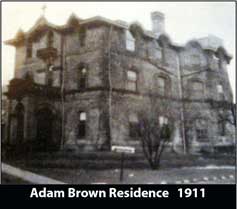
1911- Prior to 1911 the hospital was staffed with Sisters who received their training at Mercy Hospital, Kalamazoo, Michigan. By 1911 with the steady growth of the hospital, the Sisters now recognized a pressing need for additional trained nurses. The growth of the hospital led the sisters to the decision of opening a school for lay nurses.
The Sisters bought Adam Brown’s residence at the corner of St. Joseph’s Drive and Mountwood Avenue.
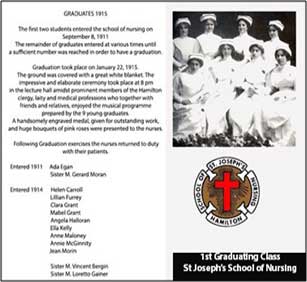
On September 8, 1911 the first students were enrolled. They were Sister M. Gerard Moran and Miss Ada Eagan. There are 8 graduates in the photo. The document with the pictures states there were 9 graduates. Archival records indicate 13 names. Pictures of the Sisters were not permitted in the graduation photos.
The first two students entered the school of nursing on September 8, 1911 The remainder of the graduates entered at various times until a sufficient number was reached in order to have a graduation.
The first graduating class of St Joseph’s School of Nursing had their ceremony on January 22, 1915. Graduation Ceremony was held in Undermount Nurses Residence. The ground was covered with a great white blanket. The impressive and elaborate ceremony took place at 8 pm in the lecture hall amidst prominent members of the Hamilton clergy, laity and medical professions who together with friends and relatives, enjoyed the musical programme prepared by the 9 young graduates. A handsomely engraved medal, given for outstanding work, and huge bouquets of pink roses were presented to the nurses. Following Graduation exercises the nurses returned to duty with their patients.

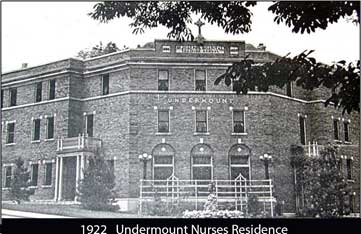
The Adam Brown building was later demolished to build a new nurses’ residence called “Undermount” under the direction of Mother Mary Thecla and Sister St. Basil. While construction was underway students were displaced in scattered living arrangements and some students lived in the hospital itself. Undermount Nurses Residence opened November 28, 1922.
The building was laid out in the form of an L, 206 feet long, located on John Street South just south of the main buildings of St. Joseph’s Hospital. Communication for the nurses and Sisters between the training school and the main hospital was afforded through a tunnel, 175 feet long, well-lighted and heated which ran under the site of the proposed Mountain Roadway.

It was a 3 storey structure with basement. Two entrances had been made at the front, one facing north for the Sisters and one facing east for the nurses. A large lecture room capable of accommodating 300 people, a demonstrating room, a cloak room for doctors and lecturers, a lunch room for nurses, and many other were found on the main floor. In the large lecture room a large crucifix hung in the main corridor at each entrance. From here one could go to the sewing room, the kitchenette and to the demonstration room. This contained very complete modern equipment for demonstrating to the nurses in training methods of procedures in various cases. Further on was the large lecture room which was equipped with a desk for chemistry, blackboards, necessary anatomical charts, and skeleton. room. The doctors cloak room was just at the entrance to the lecture room. A little lunch room was also provided where nurses could enjoy a lunch when coming off duty at night.
There were 88 single rooms and 5 double rooms and all had hardwood floors. The furniture was solid walnut, and included a large 5 drawer dresser, writing desk and chair, a rocker of walnut upholstered in tapestry, a night table and a steel, walnut finished Simmons bed. Student enrollment was 50 and the building could accommodate 100 students. The school had an up-to-date teaching unit, libraries and reception room.

Each student wore a crisp starched blue and white cotton uniform, made at home according to strict specifications.
On laundry day the garments were starched to perfection.

1924 A white apron with a three-inch waistband buttoned at the back, was worn over a long sleeve blue dress Which was accented by a starched white collar and cuffs. High Cut, laced black shoes and black stockings were worn. After a 4-month probation in the first year, a bib and cap was added. In the third year a black band was added and this signified the student as a senior. White summer uniforms were worn in special clinical areas.
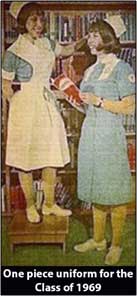
1941 Uniform was changed to short sleeves The same uniform was worn until 1968 with only some minor changes. Generations of students remember them as uncomfortable to wrestle into, with long sleeves and stiff collars held together with shoe laces. Later the uniform had shorter sleeves with stiff cuffs. Students wore white shoes with Cuban heels and white stockings.
1966- Shoes were described as “white nurses’ shoes / flat (no heels or pointed toes – Savage or Clinique brand) The graduating class of 1969 was the first class to wear one-piece uniforms. The uniform was a powder blue design with a white bib insert, displaying the School of Nursing crest on the left sleeve. Graduation uniform was a one-piece white uniform (measured by the Sisters to be just below the knee) Each student was required to purchase a blue and red cape. In 1934 they cost $9.00 and they were described as “High quality navy blue Cheviot lined with military scarlet flannel”. They were worn when the weather turned colder. The cape became less popular in the late 1960’s
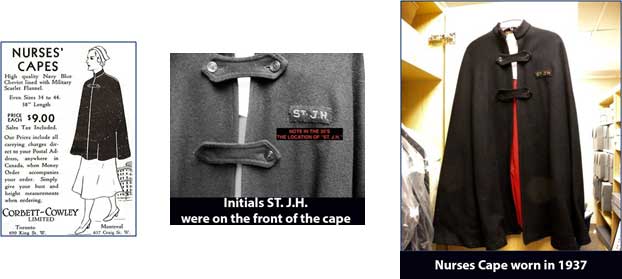
White school caps were given to each student after they had been probationers for 3 months.
This was a type of formal acceptance into the school.
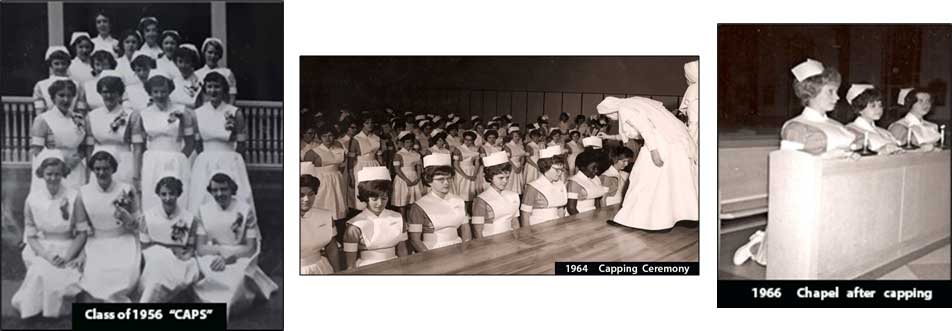
During the 1940’s to the early 1960’s the lamp was given to students when they received their cap. It was modeled after the lamp which Florence Nightingale used during the Crimean War, as she made her night rounds in the army hospital. This was later seen as a symbol of the devotion of nurses as they practiced their profession in caring for the sick and injured. By presenting it to the student nurses it congratulated them for choosing a profession with high standards in service to humanity. It was meant to be an inspiration to the young nurse.
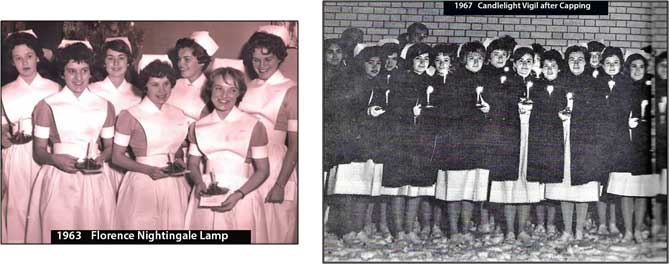
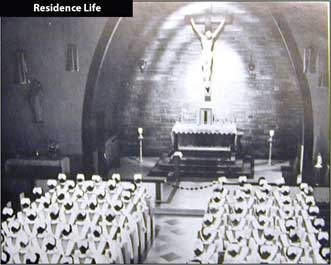
Residence Life
First day at residence new students met their “Big Sisters” (intermediate students) who gave them the rules of the residence and were available for moral support. There was a welcome party on the first night in residence. This practice continued until the students were no longer living in residence (1973).
Typical Day to the mid 1950’s
06:00 am A merciless bell rung by hand could be heard ringing up and down the halls
06:30 am Uniform inspection and attendance was taken. Everyone went to Mass.
07:30 am Breakfast before going on 12-hour ward duty.
13:00-15:00 pm Students were relieved for 1 ½ hr-2hr break.
1500-19:00 pm Classes began.
Each week students had a half-day off starting at 3:00 pm if their work was completed. In second year the ½ day off started at 1:00 pm. Residence curfew was 10 pm. meaning all students had to be in their bedrooms. One night a month there was a late leave of 11:30 pm. It was compulsory for nurses to sign in at the hospital office and return to residence via an underground tunnel
1963 Fontbonne Nurses Residence opened. Students signed in and out at the front desk.
Stipend
Stipends began in the 40’s and were gradually increased over the years. In the first year the student received $6 per month with a one dollar increase each year. By the 60’s a student received $15 per month. Anything broken or damaged was deducted from this stipend.
Protocol
There was a strong sense of seniority among students. Doors had to be opened for senior students in the cafeteria, elevators etc. Seniors went ahead of juniors and intermediates. Lipstick nail polish and rouge were not permitted. Hair was kept off the collars
Retreat
Spiritual retreats were a time of rest and regrouping of energies in the life of busy people. Retreats ordinarily happened once a year over a weekend. The weekend was a time of silence and solitude. If the time was spent well, the person often experienced feelings of peace, harmony and gratitude coming off retreat.

Students enjoyed many social activities:
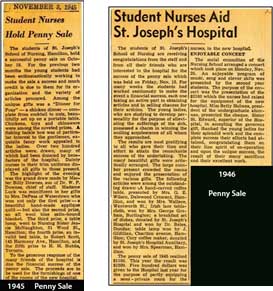
1940’s Student nurses held a penny sale. In 1945, the sale raised $1100. Proceeds were used to furnish one of the rooms of the new hospital. In 1946, the sale raised $1500. The social committee of the School of Nursing also arranged a concert. A program of music, song and clever skits was presented by the second year students. The combined amount was $2100 which the nurses had raised for the equipment of the new hospital A cheque was presented to Sister St Edward, superintendent of the hospital.

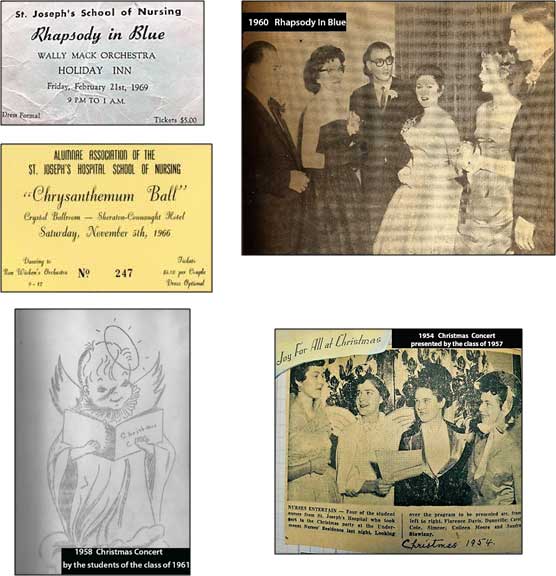
Rhapsody in Blue was a formal dance held in the spring The first dance was held in 1960 and was organized by the student council.
Students participated in Christmas concerts
Chrysanthemum Ball was a formal dance, held in the fall The first Chrysanthemum ball was held in 1950 at the Brant Inn. It was sponsored by the St Joseph’s School of Nursing Alumnae
Year Pins were received at Christmas in the 2nd year. They were worn on uniforms above the student’s name badge In 3rd year, the year pins were worn on the black band on the cap.
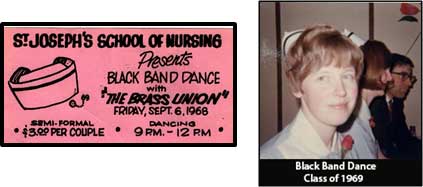
Black Bands were given traditionally to mark the beginning of the senior year. Students attended the Black Band Dance, dress was semi-formal.
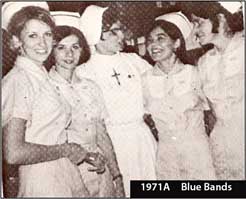
Class of 1971A was the first class to receive Blue Bands at the beginning of 2nd year.
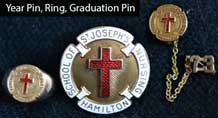
School rings were given at Christmas of 3rd year. School pins given on Graduation Day.
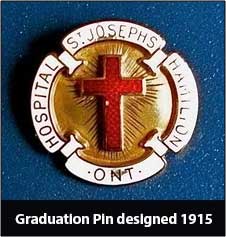
St. Joseph’s pin was designed by Sister St. Basil of the Sisters of St. Joseph while she was the Superintendent of Nurses in 1915. The pin is gold with a white enamel beveled edge which bears the words St. Joseph’s Hospital, Hamilton, Ont. In the center is a red cross. Rosary beads are visible in the cross. The students name and graduation year is engraved on the back of the pin. The pin is worn on the left side above the heart and has served as a bond for all St. Joseph’s nursing graduates.
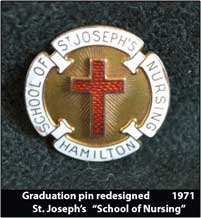
The graduation pin was redesigned in 1971 It was changed from St. Joseph Hospital Hamilton to St. Joseph School of Nursing Hamilton.
GRADUATION Many events lead up to Graduation Day.
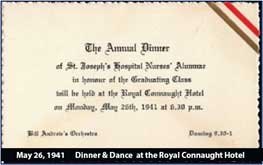
Graduation Dinner
1940’s Graduation Dinner was sponsored by the St Joseph’s School of Nursing Alumnae Association Dinner was often held on a Thursday and the Graduation dance was held on the following day.
1949 The Alumnae voted to have the annual reunion be combined with the Graduation Dinner
1964 The Graduation dinner was no longer combined with the Reunion dinner. Graduation dinner was replaced with a Graduation Tea.

Red Rose Ball was sponsored by the junior and the intermediate classes Seniors attended in full uniform.
The “Red Rose Queen” was crowned.
1965...The first Graduation Tea was held April 25th 1965. The Alumnae could no longer afford to sponsor the entire graduating class at the annual dinner. Graduation Dinner was replaced with the Mother and Daughter Tea. Alumnae continued to sponsor the Graduation Dance until 1972.
Mother Father Daughter Banquet

1959 Early yearbooks describe the “banquet” as the beginning of celebrations for Graduation. Vox Omnium 1959 is the first yearbook to describe the “MOTHER – FATHER – DAUGHTER BANQUET”. The banquet was described as the first annual occasion in honour of our parents. Students were dressed in blue and white uniforms. Parents came to the reception room of the Undermount Residence and drove the students to the Hotel. Mothers were given a gardenia corsage and the fathers were given a gardenia for their lapel.
1967 This class had 3 male graduates. The banquet was renamed the Mother – Father – Daughter – Son Banquet.
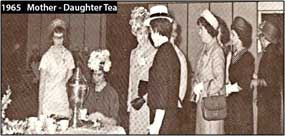
Mother-Daughter Tea
The first Graduation Tea was held on April 25, 1965, and the last graduation tea was held for the class of 1974
The graduating class were honoured by the Alumnae Executive with the Director of Nursing.
The Alumnae members poured tea for the graduating class.
A dress protocol was in place for hats suits and gloves.
Graduating class tea for the graduates and their mother or a friend.
The night before graduation the Sisters often hosted a party for the graduating class
Graduation Day began at 6:30 am with Mass celebrated in the hospital chapel with the graduates in blue and white student uniforms. There were songs and the hospital chaplain addressed the graduates. The graduating class donated red roses arranged in vases to be placed on the altar. Breakfast was served in the hospital dining room, decorated with table cloths and bouquets of flowers. Graduation ceremonies were held in various sites over the years. Archival material describes the graduating class of 1915 celebrating in the nurses' residence. Each graduate had a bouquet of pink roses. For the following years' celebrations, graduates are described as having bouquets of red roses, some descriptions mention gold ribbons, etc.
1920 Graduation ceremonies were held in St Joseph’s Hospital
1924 - 1944 Graduation ceremonies were held in Undermount Nurses Residence. Each graduate had a bouquet of red roses. A tea was held in the afternoon in the gardens on the south lawn of Undermount Nurses Residence. A celebration was held in the evening at Undermount with the students of the intermediate class providing the entertainment. 1943.states a dance was held in the evening in the nurses’ residence.



1945 - 1954 Graduation ceremonies were held in the Auditorium of the Cathedral of Christ the King . The graduates carried a bouquet of red roses. and a dance was held in the evening in Undermount Nurses Residence.
1955 Graduation ceremonies were held in the Auditorium of Westdale Secondary School.
1956 - 1963 Graduation ceremonies were held in Cathedral Girls High School.

1964 – 1970 Graduation ceremonies were held in the Auditorium of Fontbonne Nurses Residence.
1971A – 1978 Graduation ceremonies were held in Mohawk College.

Graduation Dance The Nurses Alumnae continued to sponsor the Graduation Dance until 1972.


The Foundation of Nursing Education at St Joseph’s School of Nursing
These men are credited with laying the foundation of education for the School of Nursing

1920 The Ontario Government began plans to enact a Registration Law which required all nursing students to write departmental exams on the completion of their course. This would provide extensive improvements in all schools of nursing seeking provincial approval.
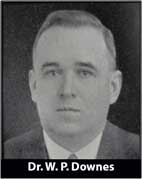
Dr Downes was the 1st intern at St Joseph’s Hospital in 1916 Dr Downes gave intensive review courses to the class of 1926, the first class to write the R. N. exams. All the students passed and for years St. Joseph’s nurses did not fail their exams. Special efforts were made to prepare the students for advanced work and in choosing candidates with superior qualifications.
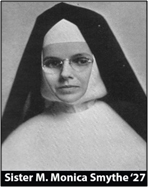
Sister M. Monica Smythe was a graduate of the class of 1927
She was the 1st Sister to write Provincial Exams
She was the Superintendent of Nurses in 1934
She was the Director of the School of Nursing from 1933 to 1940
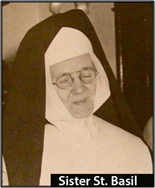
Prior to and during the 1920's
The students' priority was service to the hospital, formal education came second. Most of the nurses' training was “hands-on”. Student nurses need stamina and endurance. Classes took place in the evening after their 12-hour shift when the doctors and nurses were free to lecture.
The course was a three-year program. Students were admitted to the school and immediately assigned on the wards to 12 hr shifts. After a three-month probation period, the student nurse could be assigned to night duty. During the night shift, the hospital was staffed by students with 1 Sister Supervisor. At that time 90% of the graduate nurses did private duty nursing and the students did patient care. Students were responsible for the housekeeping in each clinical area and replaced the maid on her ½ day off to transport, serve, and clean the patient’s food trays. During 3rd year the senior nurse was responsible for incidental teaching on the wards.
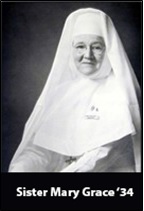
1930’s and 1940’s
Lectures increased and classes were no longer in the off-duty time.
The Sisters taught 90% of the nursing content and doctors’ lectures increased.
Sister Mary Grace Stevens
Graduate class of 1934
Hospital Administrator 1954 – 1960
and 1963 – 1971
Director School of Nursing 1940 - 1944
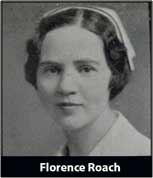
1934 Florence Roach was the 1st lay Instructress of Nursing at St Joseph’s School of Nursing
1944 Miss Sylvia Hallman the first clinical instructor at St. Joseph’s; she was assigned to assist the students in their clinical areas. Gradually more clinical Instructors were on the wards and case studies were introduced.
During WW2 the numbers in the classes increased
1940's Students did their pediatric rotation at Children’s Hospital in Detroit Michigan.
1947---The hospital started to employ graduate nurses removing service responsibilities from the students.
1947---The Sisters purchased Marygrove and Oakbank for additional nurses’ residences.
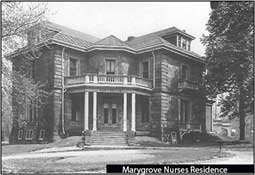
Marygrove was built in 1869
Originally the building was known as “Elmwood”, owned by Senator Andrew T. Wood in 1875.
It was located at 265 James Street South, at the corner of James St. and St. Joseph’s Drive.
The hospital purchased Marygrove on September 15, 1947, for use as a nurses’ residence.
In 1960 the building was demolished when construction of the Mary Grace Wing began.
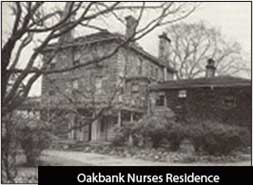
Oakbank was originally built for John Stinson in the mid-1850s.
It was located at 301 James Street South (corner of James St. and St. Joseph’s Drive), it was named for the huge, very old, oak tree in the front yard.
Edward, the Prince of Wales, stayed at Oakbank in 1860 when he attended the opening ceremonies of the city’s waterworks system.
In 1960 the building was demolished when construction of the Mary Grace Wing began.
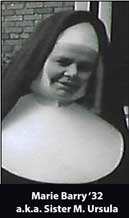
1950's In the early 50s the block system of teaching was initiated.
7:00.am to 10:00 am -- students were on the wards
10:00 am to 4 pm -- was set aside for classroom instruction
4:00 pm to 7 pm -- students were back on the wards
Records state that in the 1950s students did 3-month psychiatric affiliations at the Ontario Hospital in Toronto and at the Hamilton Ontario Hospital.
Students also did 6-week rotations at the Mountain Sanatorium, designed for the care of tuberculosis patients. Ward duty was divided between the surgical, medical and admission tuberculosis’ wards. Approximately 3 hours a day were devoted to classroom study consisting of lectures from the various doctors on the aetiology, diagnosis, treatment and rehabilitation of the disease and the patient.
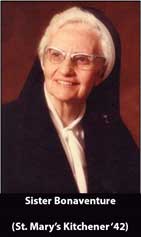
1958 Students attended the Canadian Nurses Association Convention and the Registered Nurses Association Convention.
Ward assignments were reduced from 12 hours to 8-hour shifts.
All formal classes were completed in the first two years.
The third-year was dedicated to service / clinical practice.
1960's Nurses' education reflected and responded to the many new specialities that had developed in medicine. The emphasis shifted to acquiring theory before undertaking the practice.
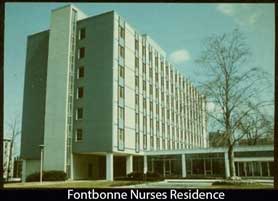
1963 Fontbonne Hall, an eight-storey nurse’s residence was opened.
1st floor had classrooms, offices for administrative staff, a fully equipped laboratory for scientific experiments, and a large library covering all fields of medicine and nursing.
The front entrance was on James St. South with a waiting room for friends and visitors.
A switchboard was located near the front entrance.
A large gymnatorium was on the 1st floor.
Floors 2, 3, and 4 had private rooms and were occupied by the senior students and the Sisters who held positions in the school.
Floors 5, 6 and 7 had double rooms and were occupied by the second-year students. On each floor, there was a lounge and a fully equipped kitchen, the roof was divided into games and T.V. areas.
First-year students were housed in the Undermount Building.

1964 The first male students entered the school in the graduating class of 1967.
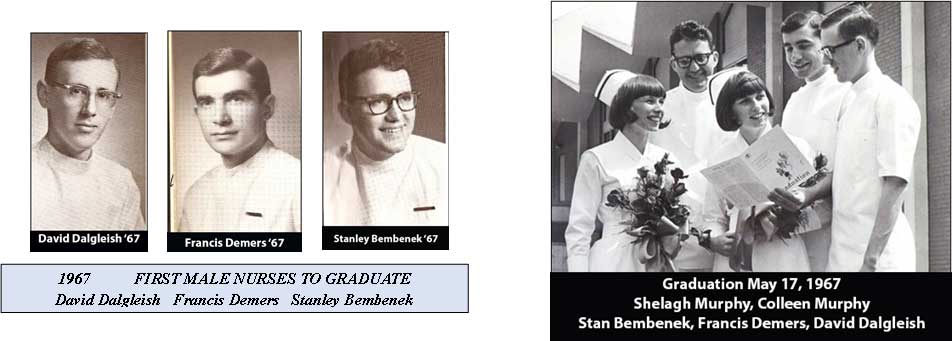
1969
The first 2 + 1 program was introduced The first 2 years of the classroom with related clinical experience were supervised by the faculty. The third-year was a practicum year with a class held once a week. Students lived in residence throughout their third year. They received $15 a month from the January of their first year until they graduated. In their third year, the students could work in the hospital as unlicensed practical nurses on their days off for $15 per shift.
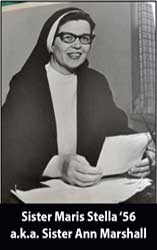
1970 and 1971A
These classes were a 2 + 1 program. Third-year was referred to as an “intern year”
1971B
First students in the 2year program.
A new self-directed two-year program began at St. Joseph School of Nursing in 1971
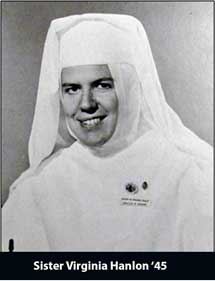
EVOLUTION OF NURSE’S EDUCATION 1911 – 1978
With the renaissance of medicine, the whole conception of care changed.
Sister Virginia Hanlon, a graduate of the class of 1945, was instrumental in obtaining better education for nursing students as well as for nursing instructors. She pioneered and advanced the education of the student nurse from Hospital Nursing Service to Nursing Theory. Sister Virginia promoted the participation of Nursing in Canadian Healthcare Education and Administration. She was the Sister Liaison to the St Joseph School of Nursing Alumnae from 1986 – 2006.
In a speech given to her Alma Mater in 1969, Sister Virginia stated that “Each new definition of nurse reflects advances in the medical and social sciences. The result has been nursing functions that are increasingly exacting and diversified.”
And so, the St. Joseph’s School of Nursing began, attracting generations of young women, and eventually some men, who felt called to a demanding and rewarding career in the care of the sick. They were disciplined, hard-working and self-sacrificing individuals who brought honour to their school and to St Joseph’s Hospital.
Sister Virginia was a teacher at St Joseph’s School of Nursing Hamilton from 1951 to 1956. She was then the Director of Nursing at St Joseph’s School of Nursing Hamilton from 1956 - 1964.
Sister Virginia was then a teacher at St Mary’s School of Nursing in Kitchener from 1964 – 1967, then Director of Nursing St Mary’s School of Nursing in Kitchener from 1967 – 1972. She then became the president and CEO at St Mary’s Hospital Kitchener from 1972 – 1976.
Her career then took her to President and CEO at St Joseph’s Home in Guelph from 1976 – 1984. She then became a member of the Administrative Staff at St Joseph’s Villa in Dundas from 1984 - 2005.
As quoted from Sister Virginia:
“The torch of tradition has now been handed over to Mohawk College, because from 1915 – 1978:
We are forever ……. A St Joe’s Grad"
EVOLUTION OF ST JOSEPH’S SCHOOL OF NURSING AND NURSING PROGRAMS IN HAMILTON
1890 A NURSES TRAINING SCHOOL WAS ESTABLISHED AT THE CITY HOSPITAL BY DR INGERSOL OLMSTED ( the Hamilton General Hospital)
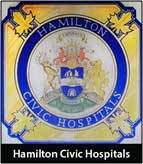
• 1891 Two nurses graduated from the City Hospital School
• 1898 Two-year Nurses Training Program increased to a three-year program
• 1942 Affiliation with McMaster University for five years of Arts and Nursing Courses.
• 1940s Block rotations were introduced into the curriculum, including three months at Psychiatric Hospital
• 1950s School of Nursing was one of the first places to isolate for “staph” infection during an epidemic.
• 1958 “Two plus one” program with third year of paid internship replaces the three-year program.
• 1964 “THE HAMILTON CIVIC HOSPITALS” are officially incorporated. The School of Nursing becomes the Hamilton Civic Hospitals Schools of Nursing.
• 1966 First School of Nursing in Canada to institute “Team Nursing”
• Total Number of graduates from Hamilton Civic Hospitals School of Nursing was 4590
• 1963 Formation of the College of Nurses followed by ONA IN 1965
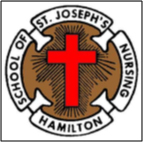
1911 ST JOSEPH’S SCHOOL OF NURSING OPENED
• On January 22, 1915, after a three-year study course, the first class of students graduated.
1920's Prior to and during the 1920s Students were admitted to the School and immediately were assigned 12 hour shifts on the wards as workers. Teaching was incidental.
• After a 3-month probation period, the student nurse could be assigned to night duty and was responsible for the housekeeping in each clinical area.
• The student replaced the maid on her ½ day time off. She transported, served meals and cleaned the patients food trays.
• The senior nurse in her third year, was responsible for incidental teaching on the wards. 90% of the graduate nurses at that time did private duty.
• During the night, the hospital was staffed by students with one Sister Supervisor.
• 1920 the Ontario government required all nursing students to write departmental exams.
• Dr Downes gave intensive review course to the class of 1926 for the first class to write the R.N. exams.
1930 - 1940's In the ’30s and '40s lectures increased and classes were no longer given during the off–duty time
• Sisters taught 90% of the nursing content and there were additional lectures given by doctors.
• Dr. I. Olmstead, Dr. J. Edgar, Dr. H. Balfe and Dr. H. Sullivan are credited with laying the foundation for the School of Nursing.
• In 1944 Miss Sylvia Hallman the first clinical instructor at St. Joseph’s, was assigned to assist the students in their clinical areas.
• Clinical Instructors were on the wards and case studies were introduced.
• During WW2 the numbers in the classes increased as did residence accommodation.
• The hospital started to employ graduate nurses removing service responsibilities from the students.
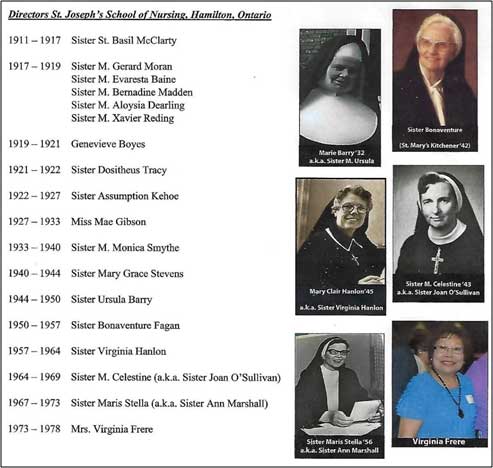
1950's In the early 1950s the block system of teaching was initiated. This new philosophy of education was met with resistance by the hospital but was finally accepted.
• The preclinical period was extended with less service and more education.
• Block System was as follows:
7:00.am to 10:00am students were on the wards
10:00 am to 4pm was set aside for classroom instruction
4:00 pm to 7pm students back on the wards.
• In 1956 ward assignments were reduced from 12 hours to 8-hour shifts, initiated with the class of 1958.
• Second year students were off the wards for longer periods with no commitment to service. All formal classes were completed in the first two years.
• The third year was dedicated to service.
• Sister Virginia was instrumental in obtaining more educational class time for the nurses and the hiring of more clinical instructors.
• Instructors were sent to University for Diplomas in Nursing Education.
• As more qualified teachers became available for clinical teaching, a great deal of the teaching took place in the hospital setting.
• With increased concentration on education rather than service, new facilities were provided for the students, an expanded library, emphasis on research and more audio/visual equipment.
• As the service and education responsibilities increased, there was a separation between service and education with a director for each area.
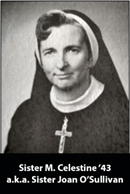
1960s’ Nurse’s education reflected and responded to the many new specialities that had developed in medicine. The emphasis shifted to acquiring theory before undertaking the practice.
• Sophisticated curriculum was developed into neurological, cardiovascular, respiratory, gastro-intestinal and genito-urinary training as well as sociology, psychology, language and communication skills.
• The school was held in high regard and it was an innovative school for self–directed learning. National and international visitors came to the school to see how it was implemented.
• Classes of ’69, ’70 and ‘71A were 2 + 1 programs.
The first 2 years of the classroom with related clinical experience were supervised by the faculty. The third-year was a practicum year with a class held once a week.
• Class of ‘71B entered the School of Nursing in September 1969 and were the first graduates of the 2-year program.
• The class of ’69 lived in residence throughout their third year, except for the married students.
• They received $15 a month from the January of their first year until they graduated. In their third year, the students could work in the hospital as unlicensed practical nurses on their days off for $15 per shift.
• Sister Ann Marshall School of Nursing Director in 1971 said “We found that most of the students by working at their own speed learned faster than ever before”.
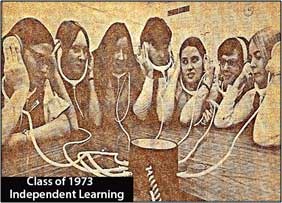
1973-1978 A new self-directed two-year program began at St. Joseph School of Nursing in the fall of 1971 for the graduating class of 1973. Students were given modules with objectives requiring knowledge, comprehension and application of information required by nurses. They identified what they needed to learn in biology, nursing theory and clinical practice. They were evaluated by pre-, and post-tests based on these objectives. The pass was 100% demonstrated in discussion with their nursing teacher as well as written exams.
• Students acquired the required information through large group sessions (usually at the beginning of the semester/course) and smaller group sessions throughout the semester/course, as determined by the group members.
• Learning Resource Centre provided two components for learning. Audio-visual resources such as slide-tapes and videos provided information to assist students to answer the objectives.
• Skills Laboratory were opened to 10:30 pm to provide an area to learn and practice skills.
• Cognitive mapping of the students helped students identify their learning styles, as a listener, and as a reader. Learning was best done with peers or authority figures.
• Nurse Technologists were available Monday to Friday from 0800 to 22:30 pm and weekends from 12:00 to 16:00 to assist students to practice skills, as well as test them prior to their performance of the skill in the clinical area. Positive re-enforcement given by the nurse technologist was well received by the students.
• Clinical experience was an essential component of the programs where students demonstrated the use of knowledge and skills learned within their small group.
• This program continued until the graduation of the class of 1975
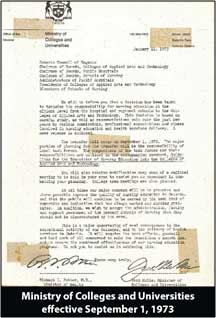
1973 The Ministry of Colleges and Universities issued a decision to move diploma nursing programs from hospitals to community colleges. The statement made was “ to transfer the responsibility for nursing education at the diploma level from the hospital and regional schools to Colleges of Applied Arts and Technology.” The transfer occurred on September 1, 1973.
GRADUATION for the Class of 1973 was the last nursing graduation under the auspices of St Joseph Hospital. Graduates of this class received their diplomas & pins from St Joseph’s School of Nursing.
Beginning September 1, 1973, the present St Joseph Hospital School of Nursing was known as Mohawk College, department of nursing, St Joseph’s Campus. Classes continued to be held in the school on James Street South.
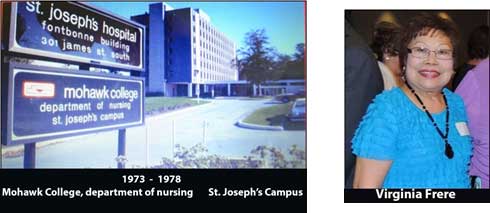

1974 Graduates of the class of 1974, received their diplomas and graduate pins from St Joseph’s School of Nursing
The last Mother-Daughter tea was held in July 1974
A new program was developed for all of the students who entered the Mohawk Nursing Program (Brantford General Campus, Hamilton Civic Campus, Hamilton District School of Nursing [Chedoke] Campus and St. Joseph’s Campus.)
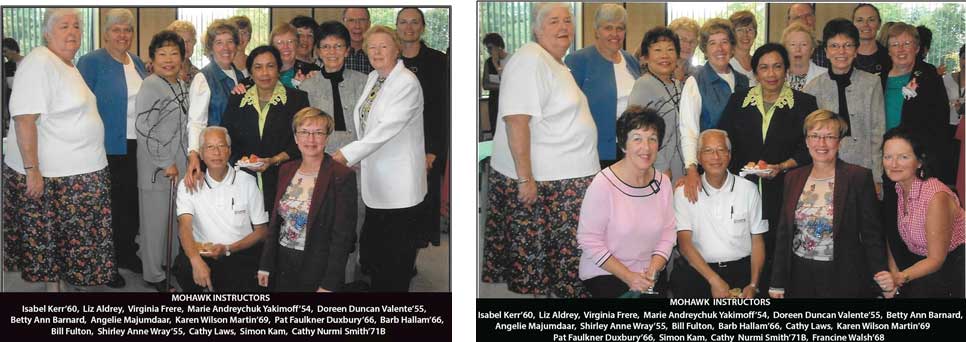
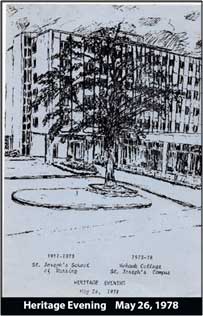
1975 Class of 1975 was the first class to graduate from Mohawk College at St Joseph’s Campus. They received their diplomas & graduate pins from Mohawk College. Fontbonne was declared for hospital use by the Ministry of Health in 1975
1978 Class of 1978 was the last class to graduate from Mohawk College at St. Joseph's Campus.
• A Heritage Evening was held for the closure of St. Joseph School of Nursing May 26, 1978 St. Joseph School of Nursing 1911 – 1973 Mohawk College, St Joseph Campus 1973 - 1978
• Total number of graduates from St. Joseph’s School of Nursing was 3450. Photos of graduates can be found in the photo gallery of this website.
• The St. Joseph’s Nursing Program would continue at Mohawk College until 1981. A new program was developed that had many similarities to the St. Joseph’s program.
• Diploma Registered Nursing program was discontinued in 2004. Mohawk College started the Baccalaureate program in conjunction with McMaster University.
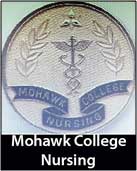
The evolution of Hamilton Schools of Nursing continued…
1964-1974 Hamilton and District School of Nursing (Hadson)
• Officially opened on October 6, 1964.
1973-1978 Mohawk College of Applied Arts and Technology Nursing
• Brantford General Campus 1973-1998
• Chedoke Campus 1973-1978
• St. Joseph’s Campus 1973-1978
• Hamilton Civic Campus 1973-1978
1978-2000: Mohawk College of Applied Arts and Technology Nursing
• Health Science Education Centre (I.A.H.S. on McMaster University grounds)
• Consolidation of all diploma Nursing sites at one location
2001-present: Registered Nursing Education moves to Bachelor of Science in Nursing
• 2001 – Inauguration of McMaster-Mohawk-Conestoga Collaborative Bachelor of Science in Nursing Degree Program (B.Sc.N)
• 2002 – Inauguration of Diploma Registered Practical Nursing Program.
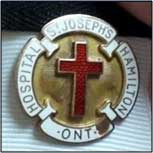
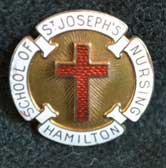
We are forever ……. A St Joe’s Grad”

